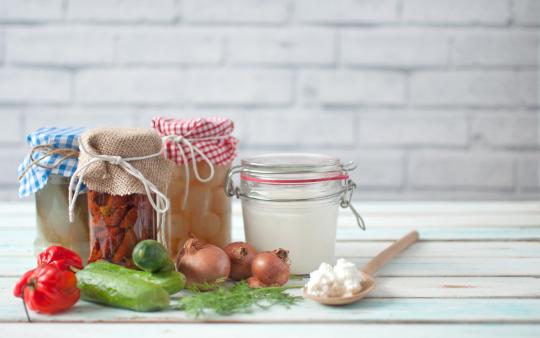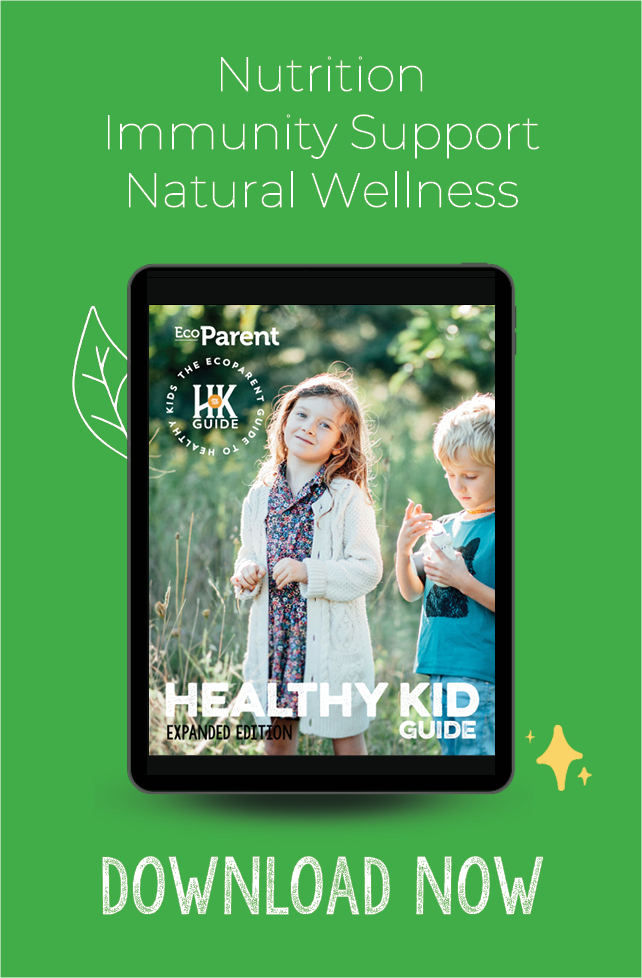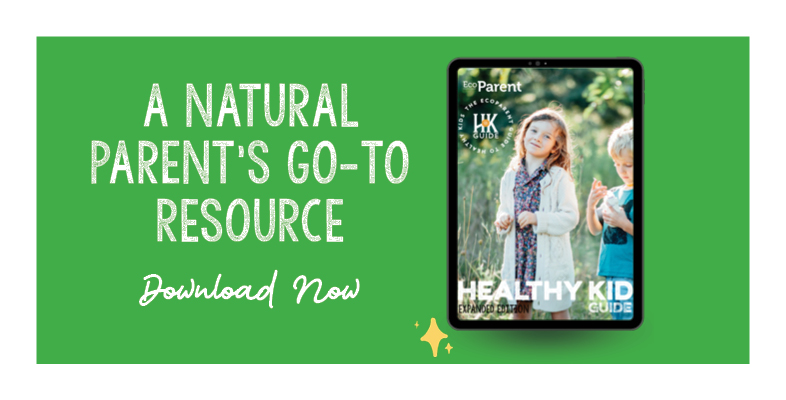It seems like common sense. We want to keep our kids safe, healthy, and germ-free.
For some parents – notably first-timers – safety and cleanliness is the holy grail of getting through childhood. Hand sanitizers, antibacterial cleaners, and things like pacifier sterilizers are all part of a very successful marketing trend towards germ-free environments. Dirt, germs and bacteria have become bad words.
But we’re learning that this strategy hasn’t worked for our health – it’s only beneficial for the companies promoting these products. Not only is it impossible to be germ-free – just try to keep the dog’s bone out of your baby’s mouth once they start crawling – but trying to be germ-free is one of the biggest reasons, we suspect, that we’re experiencing a record-setting increase in many conditions such as allergies, asthma, autoimmune problems and obesity. Infections are becoming more difficult to treat and our ideas about wellness are being re-evaluated.
The stuff we’re made of
Once upon a time, one type of bacteria caused one disease. We took a strong-acting medication called antibiotics and our disease went away. This was a golden age in medicine, where fewer children died from infections and once hard-to-cure diseases like pneumonia could be solved for most adults. It was a brave new world in health.
Now, we’ve learned about antibiotic resistance – in our fervour to swiftly eradicate infections, our medications no longer work every time as bacteria develop the ability to survive them. This overuse, along with changes in healthcare options, food systems, agriculture and hygiene, has led to unhealthy imbalances in the organisms that live in and on our bodies.
Basically, we’ve been in a war against germs, fueled by the belief that microorganisms – especially bacteria – cause disease and are bad. But in the past decade, we have been collecting more evidence about the good that is done by these little creatures that live amongst our own cells. Without them, it has been estimated that we would die in childhood with the deficiencies we would have in our immune, inflammatory and digestive systems. Surprisingly, we have approximately 10 times more microbial cells than cells of our own bodies, amounting to around 100 trillion. Cell for cell, we’re 90% microbe and 10% human – thankfully our human cells are much bigger, otherwise we’d likely look much different than we do. The development of these bacteria is most important in the first few years of life. The fact that we are being encouraged by corporations (and sometimes well-meaning friends, family members and even health-care providers) to be hypervigilant, clean, and use more medications which affect this development is distressing. It’s not only a risk for our kids in childhood but it can follow them for a lifetime.
Get the germs in!
For over a century, we’ve mistakenly believed that babies were born sterile and didn’t have any of these micro-organisms in or on their bodies until after they were born. But the process starts with moms during pregnancy. Not only can your own bacteria affect your baby during pregnancy, it will migrate to your vaginal canal and mammary glands to be passed directly to your baby during the birthing process and breastfeeding. These bacteria, if coming from a healthy mom with a healthy microbiome (the entire system of microorganisms in a body), are going to support your baby through a time when their immune system and digestive tracts are not fully developed.
Vaginal birth: the passage of best resistance
In North America, we’re not doing very well. To begin with, and for the above-mentioned reasons, many moms might not go through pregnancy with an optimal bacterial mix. Aside from this, elective C-section birth rates continue to rise worldwide. In Canada our rates for C-section are at approximately one in four, in the US it’s just under one in three and in China it’s almost half. C-section birth does not allow for a transfer of maternal bacteria at all. Not-so-fun fact: the first main bacteria a C-section baby will be exposed to come from the hospital setting and the skin of the individuals who hold the newborn.
There is a study presently occurring that looks at whether we could manually pass along the vaginal bacteria of the mom to C-section babies and lower the risk for asthma, allergies and obesity seen frequently with a non-vaginal birth. The preliminary results show some benefit – using gauze to collect vaginal bacterial samples and transferring them to the babies born via C-section did increase bacterial populations – but only partially when measured against vaginally-born babies. This makes sense because labour and descent through the birth canal is a long process compared to a brief smear of gauze on the face. And bacteria multiply quickly, so as the baby is descending through the birth canal, they can begin to grow and multiply even before they’re outside of the mother. So, while this procedure may give some benefit to C-section babies, it is not replacing the benefits of having a natural vaginal birth when possible.
The kindness of human milk
Breastfeeding is the next major area that helps to build a healthy group of bacteria. We’ve known that mothers pass along bacteria to their infants in breastfeeding, but it was assumed it was transferred from the skin. Over 200 bacteria have been identified in breast milk, although the average mom will only transfer about 8-10 different kinds. Breast milk (amazing stuff that it is) also provides the food for those bacteria to grow and thrive. For years, it was a mystery as to why breast milk contained a nutrient called human milk oligosaccharide (HMO) which babies, like all humans, cannot break down or use. But bacteria can. It is one of their favourite foods and it helps bacteria like bifidobacteria infantis colonize so they can promote a healthy immune and inflammatory system.
A 2013 study from the Canadian Medical Association Journal showed that only 15% of Canadian moms are solely breastfeeding for six months. Early introduction to food or to the wrong foods can also affect our collection of microorganisms and the earlier it happens, the more risk there seems to be. Weaning and food introduction is a double-edged sword. Food is most likely the biggest factor that, on a day-to-day basis, affects our microbiome. Another recent study demonstrated that even in a day we could get a statistically significant change in our bacteria based simply on what we eat.
Food – it does a body good
It seems that bacteria like us to eat food – not only that, they need us to eat food. As a naturopathic doctor, I like us to eat food too. Too bad it doesn’t happen nearly as often as I’d prefer. Instead, we eat food-like substances: products that look like food but mainly contain the same repeated set of substandard nutrients infused with fat, sugar, salt and chemicals. Turns out this does not promote a good set of bacteria and can actually program children to want more and more of that type of food. Food cravings, obesity and glucose intolerance all seem to have a relationship with the balance of bacteria that results from what we choose to eat.
Childhood is a definitive time when it comes to eating. What we’re seeing so far is that what we’ve all been talking about for decades is being demonstrated in research – whole, unprocessed foods with lots of plant fibres seem to be best. So what can we do to promote healthy food choices in our children that, in turn, will promote a healthy set of bacteria?
Choose variety
On the topic of introducing solids, I do recommend promoting variety in the diet of our children once beyond the age of 6 months. While you don’t want to introduce too many foods all at once, the theory of avoiding lots of food until children are older doesn’t seem to lower risk for asthma and allergies (except for dairy and honey). Iron-rich foods like meat, fish, poultry, cooked eggs, well-cooked beans and lentils can be introduced first along with vegetables and fruits. As much as possible, cooking these foods yourself is much better than buying pre-packaged preparations. Anything that doesn’t rot is not a good option for our bacterial inhabitants!
Avoid artificial ingredients
This includes preservatives, chemicals, or artificial sugars. When the in-laws or well-meaning friends assert it’s their right to give treats and snacks to your young ones and you don’t know how to support your argument, here’s your rational, science-based reply: if we were just made up of human cells, the chemicals we ingest through food might not be enough to individually affect tissues (which is how safety studies are often done) but they do affect the individual cells of our microbiota. A recent study also demonstrated that artificial sugar, through our bacteria, could cause glucose intolerance. This was in adults – we don’t know what could happen when we give it to our children in their developmental time.
Eat dirt!
Grow a garden. The microbiota from the soil is so important and beneficial – what we can get from the food we grow in organic soil is much beyond its nutrients. Whether it’s herbs on the window sill in the winter time or a tomato plant in the summer, most of us can grasp the basics of growing food. Bonus: it teaches many valuable lessons to our children beyond the benefits to their bacteria.
Get fermenting
And finally, eat fermented foods. Even better, make them at home. From yogurt to kimchi to sauerkraut, the benefits of fermented foods are massive. Using bacterial culture to process food is an age-old technique that not only promotes better food production but better health.
The development of the microbiota of our children is an important process that starts from conception. As the basic pattern of our bacteria and how they relate to development of our immune and inflammatory system is set by the end of the first few years of life, the choices we make for our children during this time is vital. It goes far beyond our choices in birthing methods, breastfeeding and food and extends to our choices with medications, where we live, whether our kids have pets or siblings, and a host of other elements. Thankfully, the majority of the factors are within our control – especially the food we feed our children and our choices of household products. Let kids get outside and play in the dirt, pet an animal (and maybe even let it lick them! Ew!), touch worms (Ew ew!), grow gardens and support local agriculture that does not involve chemicals and the inappropriate and unnecessary use of antibiotics. All of these choices will support the health of your child, not only today, but well into their future and even their children’s future.









